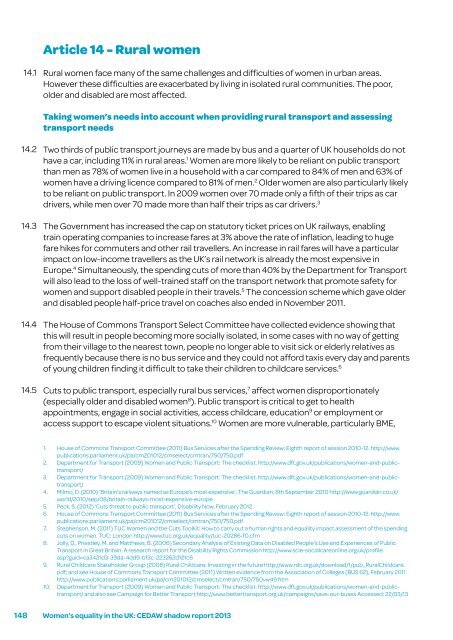Women’s equality in the UK – A health check
Women’s equality in the UK – A health check
Women’s equality in the UK – A health check
You also want an ePaper? Increase the reach of your titles
YUMPU automatically turns print PDFs into web optimized ePapers that Google loves.
14.1<br />
14.2<br />
14.3<br />
14.4<br />
14.5<br />
Article 14 - Rural women<br />
Rural women face many of <strong>the</strong> same challenges and difficulties of women <strong>in</strong> urban areas.<br />
However <strong>the</strong>se difficulties are exacerbated by liv<strong>in</strong>g <strong>in</strong> isolated rural communities. The poor,<br />
older and disabled are most affected.<br />
Tak<strong>in</strong>g women’s needs <strong>in</strong>to account when provid<strong>in</strong>g rural transport and assess<strong>in</strong>g<br />
transport needs<br />
Two thirds of public transport journeys are made by bus and a quarter of <strong>UK</strong> households do not<br />
have a car, <strong>in</strong>clud<strong>in</strong>g 11% <strong>in</strong> rural areas. 1 Women are more likely to be reliant on public transport<br />
than men as 78% of women live <strong>in</strong> a household with a car compared to 84% of men and 63% of<br />
women have a driv<strong>in</strong>g licence compared to 81% of men. 2 Older women are also particularly likely<br />
to be reliant on public transport. In 2009 women over 70 made only a fifth of <strong>the</strong>ir trips as car<br />
drivers, while men over 70 made more than half <strong>the</strong>ir trips as car drivers. 3<br />
The Government has <strong>in</strong>creased <strong>the</strong> cap on statutory ticket prices on <strong>UK</strong> railways, enabl<strong>in</strong>g<br />
tra<strong>in</strong> operat<strong>in</strong>g companies to <strong>in</strong>crease fares at 3% above <strong>the</strong> rate of <strong>in</strong>flation, lead<strong>in</strong>g to huge<br />
fare hikes for commuters and o<strong>the</strong>r rail travellers. An <strong>in</strong>crease <strong>in</strong> rail fares will have a particular<br />
impact on low-<strong>in</strong>come travellers as <strong>the</strong> <strong>UK</strong>’s rail network is already <strong>the</strong> most expensive <strong>in</strong><br />
Europe. 4 Simultaneously, <strong>the</strong> spend<strong>in</strong>g cuts of more than 40% by <strong>the</strong> Department for Transport<br />
will also lead to <strong>the</strong> loss of well-tra<strong>in</strong>ed staff on <strong>the</strong> transport network that promote safety for<br />
women and support disabled people <strong>in</strong> <strong>the</strong>ir travels. 5 The concession scheme which gave older<br />
and disabled people half-price travel on coaches also ended <strong>in</strong> November 2011.<br />
The House of Commons Transport Select Committee have collected evidence show<strong>in</strong>g that<br />
this will result <strong>in</strong> people becom<strong>in</strong>g more socially isolated, <strong>in</strong> some cases with no way of gett<strong>in</strong>g<br />
from <strong>the</strong>ir village to <strong>the</strong> nearest town, people no longer able to visit sick or elderly relatives as<br />
frequently because <strong>the</strong>re is no bus service and <strong>the</strong>y could not afford taxis every day and parents<br />
of young children f<strong>in</strong>d<strong>in</strong>g it difficult to take <strong>the</strong>ir children to childcare services. 6<br />
Cuts to public transport, especially rural bus services, 7 affect women disproportionately<br />
(especially older and disabled women 8 ). Public transport is critical to get to <strong>health</strong><br />
appo<strong>in</strong>tments, engage <strong>in</strong> social activities, access childcare, education 9 or employment or<br />
access support to escape violent situations. 10 Women are more vulnerable, particularly BME,<br />
1. House of Commons Transport Committee (2011) Bus Services after <strong>the</strong> Spend<strong>in</strong>g Review: Eighth report of session 2010-12. http://www.<br />
publications.parliament.uk/pa/cm201012/cmselect/cmtran/750/750.pdf<br />
2. Department for Transport (2009) Women and Public Transport: The <strong>check</strong>list. http://www.dft.gov.uk/publications/women-and-publictransport/<br />
3. Department for Transport (2009) Women and Public Transport: The <strong>check</strong>list. http://www.dft.gov.uk/publications/women-and-publictransport/<br />
4. Milmo, D. (2010) ‘Brita<strong>in</strong>’s railways named as Europe’s most expensive’, The Guardian, 8th September 2010 http://www.guardian.co.uk/<br />
world/2010/sep/08/brita<strong>in</strong>-railways-most-expensive-europe<br />
5. Peck, S. (2012) ‘Cuts threat to public transport’, Disability Now, February 2012<br />
6. House of Commons Transport Committee (2011) Bus Services after <strong>the</strong> Spend<strong>in</strong>g Review: Eighth report of session 2010-12. http://www.<br />
publications.parliament.uk/pa/cm201012/cmselect/cmtran/750/750.pdf<br />
7. Stephenson, M. (2011) TUC Women and <strong>the</strong> Cuts Toolkit: How to carry out a human rights and <strong>equality</strong> impact assessment of <strong>the</strong> spend<strong>in</strong>g<br />
cuts on women. TUC: London http://www.tuc.org.uk/<strong>equality</strong>/tuc-20286-f0.cfm<br />
8. Jolly, D., Priestley, M. and Mat<strong>the</strong>ws, B. (2006) Secondary Analysis of Exist<strong>in</strong>g Data on Disabled People’s Use and Experiences of Public<br />
Transport <strong>in</strong> Great Brita<strong>in</strong>. A research report for <strong>the</strong> Disability Rights Commission http://www.scie-socialcareonl<strong>in</strong>e.org.uk/profile.<br />
asp?guid=ca3421d3-39da-4dd9-bf3c-223262d121c6<br />
9. Rural Childcare Stakeholder Group (2008) Rural Childcare: Invest<strong>in</strong>g <strong>in</strong> <strong>the</strong> future http://www.rdc.org.uk/download/1/pub_RuralChildcare.<br />
pdf; and see House of Commons Transport Committee (2011) Written evidence from <strong>the</strong> Association of Colleges (BUS 62), February 2011<br />
http://www.publications.parliament.uk/pa/cm201012/cmselect/cmtran/750/750vw49.htm<br />
10. Department for Transport (2009) Women and Public Transport: The <strong>check</strong>list. http://www.dft.gov.uk/publications/women-and-publictransport/<br />
and also see Campaign for Better Transport http://www.bettertransport.org.uk/campaigns/save-our-buses Accessed: 22/03/13<br />
148 <strong>Women’s</strong> <strong>equality</strong> <strong>in</strong> <strong>the</strong> <strong>UK</strong>: CEDAW shadow report 2013


